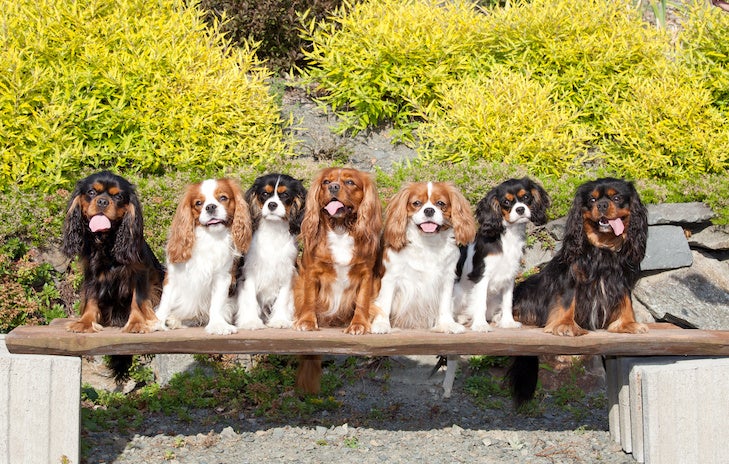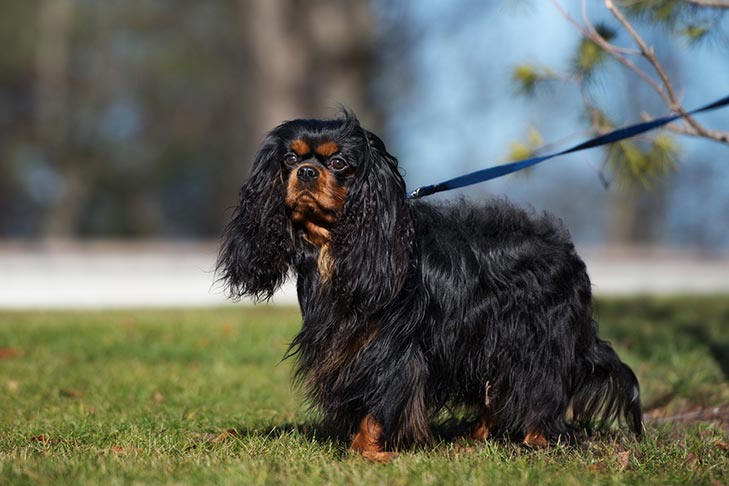AKC is a participant in affiliate advertising programs designed to provide a means for sites to earn advertising fees by advertising and linking to akc.org. If you purchase a product through this article, we may receive a portion of the sale.
The Cavalier King Charles Spaniel’s medium-long luscious coat and silky, feathery ears signal royalty. Keeping this breed at their elegant, tangle-free best calls for a little time and some routine upkeep.
But there’s no need to worry. At 13–18 pounds, this toy dog is easy to lift and portable enough to bathe in most kitchen sinks or home bathtubs. You can also forget about heavy-duty clipping, trimming, and fluffing.” Cavaliers are a natural breed with a single coat,” says Cindy Huggins, judges’ education chairperson for the American Cavalier King Charles Spaniel Club. “Few Cavaliers have unmanageable coats.”
The toy spaniel’s sweet expression with large, round eyes—a hallmark of the breed—and noble demeanor looks best with regular brushing and bathing. Add on nail and pad trimming for injury-free feet and dental cleaning for good health.
Cavalier Grooming Basics
“Begin by slowly acclimating your Cavalier to having his body, including his face, mouth, ears, and feet handled,” says Terri Becker, president of the California Professional Pet Groomers Association. “Days before you bathe your dog, turn the pet dryer on and off a few times until he feels comfortable with the noise.”
Preservation breeders begin bathing, brushing, and trimming their puppies’ nails and feet weeks after birth. Once your puppy comes home, give them a week or two to settle in before continuing the routine.
The breed’s four distinct color patterns—Blenheim (chestnut markings on a white background), Tricolor (black markings on a white background), Black and Tan (black with tan markings), and Ruby (a rich red)—all require the same care.
For Cavalier owners who want to take their dogs to a professional groomer, Becker recommends brushing their dogs every day and then visiting the groomer every four to six weeks. “If your Cavalier isn’t a show prospect and you don’t want to deal with a long canine coat, ask the groomer to give your dog a modified Cocker pet cut,” says Huggins.

Importance of Daily Brushing
With moderate to long coats, you’ll need to keep knots from forming along the dog’s ears, chest, back of the legs, tail, and the underbelly. “A daily 10-minute brush-out is a must,” Huggins says. “Begin by lightly misting the silky coat with water and brush around the ears and skirts before brushing all the fringe. Brushing pulls out the dead hair, and the coat should lie flat and feel soft.” Use a boar bristle brush or a pin brush. A pin brush is a wooden brush with widely spaced wire pins and a ball at one end to avoid damaging the coat.
Like all dogs, Cavaliers do shed, but daily brushing confines hair to the brush rather than around the house. “Cavalier shedding isn’t seasonal,” says Huggins. “The breed drops hair all year long, but it’s manageable if you keep a lint brush around and don’t like wearing black wool.”
How to Bathe a Cavalier
After you’ve brushed out the mats, your dog is ready for their spa day. For Cavaliers who don’t go to dog shows, a monthly bath helps freshen up and keep the coat healthy.
“Apply a canine shampoo with a mild, low-residue formula, rinse with water that feels cooler than you bathe in, and top off the bath with a crème rinse conditioner,” says Huggins. Use a canine dryer, which has a cooler temperature than a human hairdryer.
Cavalier show dogs are bathed weekly, the day before competing. “Before a show, skip the crème rinse, but spritz a finishing spray,” says Huggins. “Add a drying coat for a few hours or overnight to flatten your Cavalier’s hair to avoid it from curling.” A canine drying coat is lightweight but double thick and wicks moisture away from the hair.

Trimming a Cavalier’s Nails
“If you hear your dog’s nails clicking on the floor, it’s time to trim them,” says Becker. “Use nail clippers once every three to four weeks.” A professional groomer can trim your dog’s nails, but with patience and practice, you can master the skill. (Cavalier show exhibitors like to keep their dogs’ nails short and trim them weekly.)
Hair grows quickly on the bottom of the breed’s paws, between the pads of the toes. To avoid your Cavalier slipping on slick surfaces, trim the hair weekly with blunt-nose, curved scissors. “Don’t trim the top of the feet, as feathering on the feet is a feature of the breed,” says Huggins.
Establishing a Dental Health Routine
Like many toy breeds, Cavaliers require daily oral cleaning. Some dogs will accept a small canine toothbrush with a tasty canine toothpaste, while others may not.
“I like to take a thin washcloth, dip it in some hydrogen peroxide and wrap it around my finger,” suggests Huggins. “I rub my dog’s teeth and gums with it every day to prevent inflammation.” If you’re unable to care for your dog’s teeth, take them to the veterinarian for a professional cleaning every three to four months.

Caring for Cavalier Ears, Eyes, and Skin
Framing the face with lush feathering, Cavalier ears are the dog’s crowning glory. These heavy drop ears protect the middle and inner hearing canals, but block air from circulating underneath. As a result, owners need to do a daily check and clean excessive wax and debris accumulation that leads to ear infections.
To keep your dog’s neck and ears dry and clean during mealtime, protect them with a soft, cotton head covering, or snood. “Train your dog to allow you to check his ears and clean them when necessary,” Becker says.
Many Cavaliers are prone to continual eye stains until all their adult teeth grow in. “It doesn’t matter what food you feed them,” says Huggins. “Some breeders will apply petroleum jelly under the eyes on the tear track every morning and rinse it off at night. They repeat the process the next day.”
The hardest part of grooming your Cavalier is setting aside the time and assembling the materials, but your reward is a healthy, clean dog who is grateful for the attention and care.
This article is intended solely as general guidance, and does not constitute health or other professional advice. Individual situations and applicable laws vary by jurisdiction, and you are encouraged to obtain appropriate advice from qualified professionals in the applicable jurisdictions. We make no representations or warranties concerning any course of action taken by any person following or otherwise using the information offered or provided in this article, including any such information associated with and provided in connection with third-party products, and we will not be liable for any direct, indirect, consequential, special, exemplary or other damages that may result, including but not limited to economic loss, injury, illness or death.

